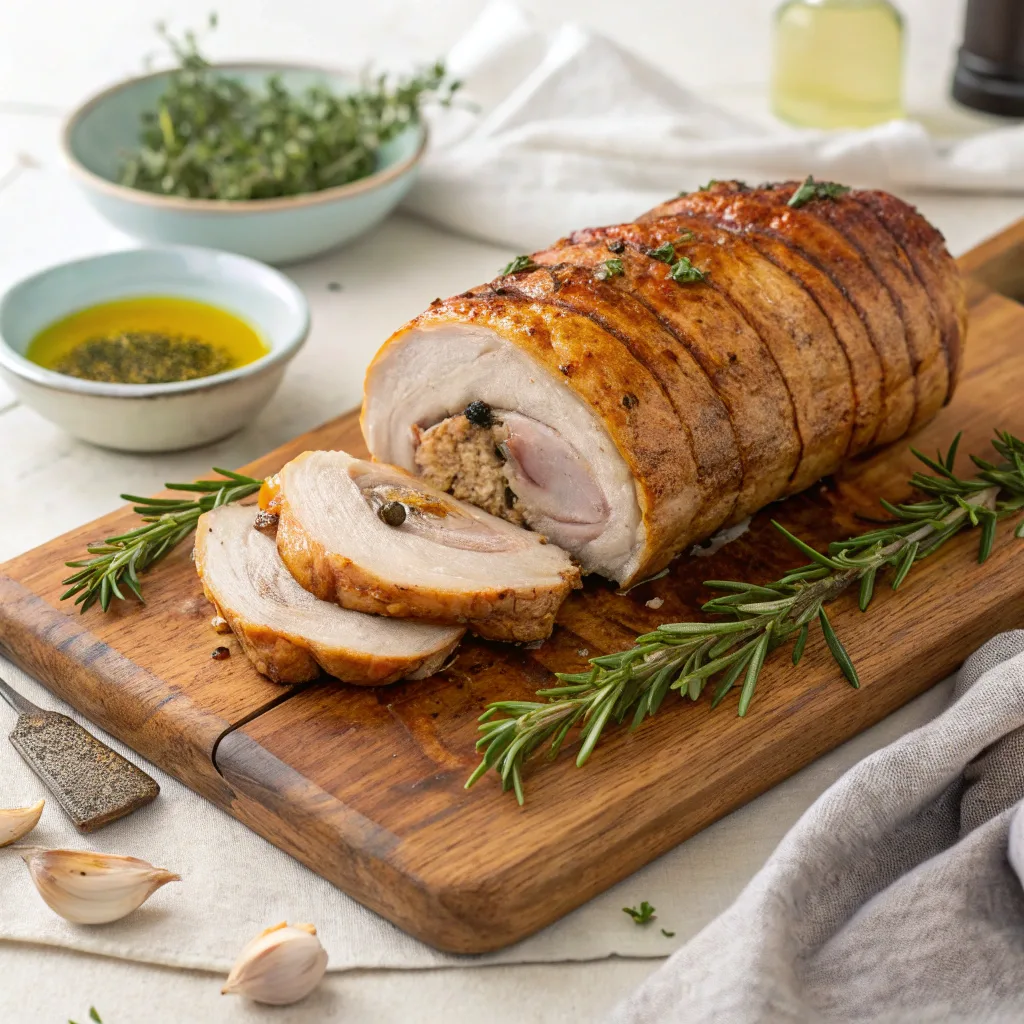Jump to Recipe
There is something magical about the smell of a homemade porchetta filling your kitchen. When I made this dish for the first time, it took me back to a small Italian village, where each bite of the crispy skin and tender meat felt like a hug from a loving grandmother. This real porchetta recipe is what Italian food is all about. It has just the right amount of each flavor to make your mouth dance.
As someone who loves to cook, I can’t wait to share my favorite techniques and porchetta cooking tips with you. This guide on how to roast porchetta will help you a lot, whether you’re a skilled cook or just love skilled food.
We’ll talk about the important ingredients, the step-by-step process, and my tips for always making sure your Italian roast pork is juicy and full of flavor. Let’s go on this wonderful culinary adventure together and make a masterpiece that everyone will love.
Porchetta’s history and tradition
Porchetta has a long history dating back to central Italy. It has become a symbol of Italian food traditions because of how delicious it tastes and how crispy the skin is. This tasty treat has its roots in the country; it started out small but has become famous all across the country.
During the Roman era, the practice of seasoning and slow roasting whole pigs demonstrated the region’s deep understanding of pork roasting history.
This is where porchetta got its start. Using the right amount of herbs and spices and careful roasting has improved this method over time, creating a dish that is unique in both taste and cultural significance.
It’s more than just food; porchetta is a sign of celebration. Traditionally served at festivals and community events, porchetta fosters camaraderie, embodying the essence of Italian hospitality.
Porchetta is an important part of Italian culture because it is often the main dish at large events. It shows how passionate and united the Italian people are about their food.
People who work hard to keep the original ways of making porchetta alive make sure that future generations will enjoy this culinary gem. By learning about its history and using traditional methods, we can enjoy the history and flavor that this dish brings to our tables.
Choosing the Perfect Pork Cut
Picking the right cut of pork is essential for making a tasty and moist porchetta. Let’s talk about the importance of fat content, what the best cuts are, and how to find fresh pork that is butcher-quality.
The Importance of Fat Content
When making porchetta, the amount of fat in the pork is very important. Not only does fat make food taste better, it also keeps meat juicy while it roasts. If the cut is well marbled, the end result will be juicy and full of flavor.
Different Cuts for Different Results
For a traditional porchetta, you might want to use pork shoulder or belly. Because pork belly has the right ratio of meat to fat, the bites are tender and crispy.
Another excellent choice is the shoulder cut, which is known for having a lot of flavor and fat. If you want a tasty porchetta, either cut of pork could be the best choice.
Where to source quality pork
If you want this dish to taste its best, you must use pork that is of butcher-quality. I think you should go to a local farmers’ market or butcher shop.
The food at these places is usually fresher than what you can find in a supermarket. Choose cuts with lots of marbling, and ask your butcher what the best pork cut is. They will be able to help you find the best pieces for your needs.

Preparing the Porchetta: Seasoning and Marinade
Choosing the right ingredients is the first step in making the perfect porchetta. The porchetta seasoning is one of the most important parts because it brings out the pork’s great flavors. Traditional Italian herbs are crucial to this mix.
Essential herbs and spices
Use a mix of traditional Italian herbs, such as rosemary, garlic, and fennel, to get that famous porchetta taste. Not only do these ingredients smell good, they are also crucial for giving the meat flavor. A well-balanced mix of spices will make your dish taste more like real Italian food.
Creating a Flavorful Marinade
Next, we’ll make a rich and fragrant marinade for pork. Add lemon zest, chopped garlic, crushed fennel seeds, fresh rosemary, and a little olive oil to a bowl. This mixture creates a robust marinade that enhances the porchetta seasoning’s flavors and ensures the meat absorbs these delectable flavors completely.
Marination Tips for Maximum Flavor
Let the pork sit in the sauce for at least 24 hours for the best results. This allows the traditional Italian mix of herbs and spices to really penetrate the meat. To get the most flavor out of the marinade, massage it well into the pork, making sure it gets into all of the cracks.
If you follow these steps, you’ll be well on your way to making a porchetta that tastes like real Italian food.

Porchetta
Ingredients
Method
- Prepare the Marinade: In a bowl, mix the garlic, rosemary, fennel seeds, lemon zest, olive oil, salt, and pepper.
- Season the Pork: Lay the pork flat, skin-side down. Spread the marinade evenly across the pork, massaging it well into the meat.
- Roll the Pork: Roll the pork tightly into a log, securing it with kitchen twine.
- Marinate: Cover and refrigerate for at least 24 hours, allowing the flavors to soak in.
- Preheat Oven: Heat the oven to 325°F.
- Roast: Place the pork in a roasting pan, skin-side up. Roast for about 25 minutes per pound until the internal temperature reaches 145°F.
- Crisp the Skin: For crispy skin, increase the oven temperature to 450°F for the last 20–30 minutes of cooking. Watch closely to avoid burning.
- Rest and Serve: Let the porchetta rest for 15 minutes before slicing. Serve and enjoy!
Notes
If using a slow cooker, sear the pork first in a skillet, then cook on low for 6–8 hours.
Grilling is an option, too! Cook over indirect heat, turning occasionally, until done.
Cooking Techniques for Perfect Porchetta
To get that perfect balance of crispiness and tenderness, you need to learn how to cook porchetta. Let’s look at three common ovens. You can roast in the oven, on the grill, or in a slow cooker. Using a slow cooker, the porchetta tastes and feels different, making the experience unforgettable.
Oven Roasting
The oven is your best friend when you want to roast porchetta. Roasting in the oven can produce crispy skin and juicy meat. Warm the oven up to 325°F.
After cooking your porchetta for about 25 minutes per pound, ensure that the internal temperature reaches 145°F. With this method, the skin stays golden brown and crunchy, and the meat stays juicy.
Grilling Options
If you like smoky flavors, you could grill your porchetta. There are different ways to grill meat that let you add a subtle smoke flavor. Keep the porchetta away from direct flames, and use indirect heat. Keep the grill at a steady 350°F temperature. To ensure even cooking and a perfect sear, flip the food every so often.
Using a Slow Cooker
Porchetta cooked in a slow cooker is excellent for people who would rather not be involved. This method requires little work but guarantees tender, tasty results.
Set the timer to low (8 to 10 hours) or high (4 to 6 hours). The slow, even heat breaks down the meat fibers, making the meat melt in your mouth.
You can make your porchetta taste even better by trying these different cooking methods. This is an Italian classic that will impress your guests.
FAQ
What is the most authentic porchetta recipe?
The most authentic porchetta recipe is based on traditional Italian methods that emphasize high-quality pork with the right amount of fat and lean meat. Some of the most important ingredients are pork belly or shoulder, rosemary, garlic, and fennel seeds. All of these help the roast smell and taste great.
How do I roast porchetta at home to make it juicy?
If you want your porchetta to be juicy, you need to use a cut of pork with a lot of fat, like pork belly. Use a lot of herbs and spices to season the meat, and roast it at a high temperature at first to make the skin crispy. Then, lower the heat and cook the meat slowly and steadily. This method keeps the juices inside while making the outside crispy.
Why is fat content important in porchetta?
When the meat roasts, the fat in the porchetta renders, adding flavor and moisture. This makes pork that is juicy, tender, and full of flavor. People love cuts such as pork belly because they have just the right amount of fat and lean meat.
What are the essential herbs and spices for porchetta?
Rosemary, sage, fennel seeds, garlic, and black pepper are some of the most important herbs and spices for porchetta. These herbs and spices bring out the traditional flavors of the dish, enhancing the taste of the pork.
How do I create a flavorful marinade for porchetta?
Mix olive oil, minced garlic, crushed fennel seeds, chopped rosemary, sage, salt, and pepper together to make a tasty marinade for porchetta. Spread this mixture all over the pork, making sure it goes all the way through the meat. Let it sit for a few hours or overnight to extract the most flavor.
What roasting techniques yield the best porchetta?
To get a crispy skin on the porchetta, start the roasting process with a high oven temperature. Then, lower the heat and let the meat cook slowly so it’s evenly cooked and tender. The porchetta stays moist as long as it is basted regularly and its temperature is checked frequently.
Can I grill porchetta instead of roasting it?
You can cook porchetta on a grill. The herbal seasoning goes well with the slightly smoky flavor that comes from grilling. Slowly and evenly cook the pork over indirect heat, turning it every so often to get an even crust. After grilling, let the meat rest so that the juices can spread out again before serving.
How do I use a slow cooker for porchetta?
A slow cooker is a convenient way to make porchetta that doesn’t lose any flavor. After seasoning the pork, sear it in a hot skillet to create a crust, and then transfer it to the slow cooker. Low-key cook the pork for 6 to 8 hours, until it’s soft and juicy. If you want the skin to be really crispy, finish by broiling it in the oven.
Why is porchetta a significant dish in Italian culinary traditions?
Because it has a long history of consumption in groups and at festivals, porchetta plays a significant role in Italian culture. It comes from central Italy and is a traditional food at celebrations and festivals. It represents plenty, as well as the value of sharing meals. Its traditional preparation methods show how much the Italians care about quality and taste.
Where can I source high-quality pork for porchetta?
Visit reputable butcher shops or farmers’ markets in your area to get high-quality pork. Choose cuts like pork belly or shoulder that have a suitable amount of fat and meat, and make sure they are fresh. Making friends with your butcher can also help you choose porchetta cuts.
